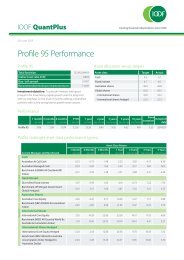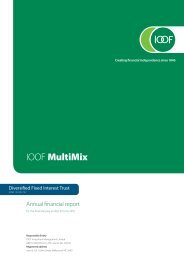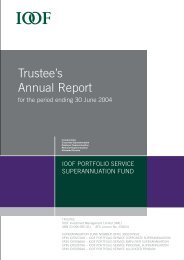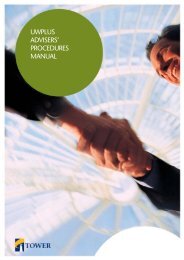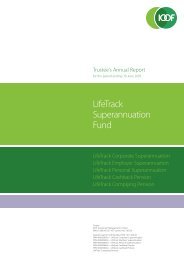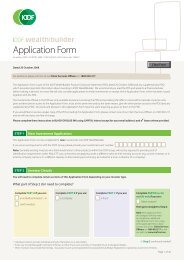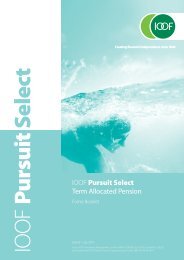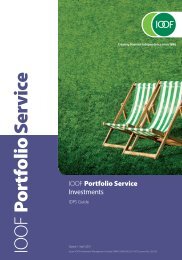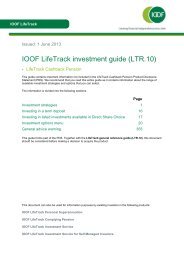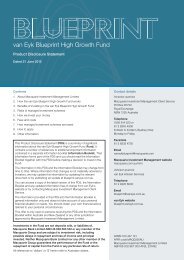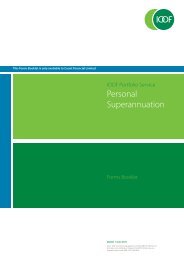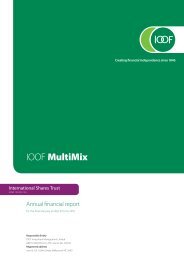annual report 2011
annual report 2011
annual report 2011
You also want an ePaper? Increase the reach of your titles
YUMPU automatically turns print PDFs into web optimized ePapers that Google loves.
IOOF | <strong>annual</strong> <strong>report</strong> <strong>2011</strong><br />
Notes to the financial statements (cont’d)<br />
For the year ended 30 June <strong>2011</strong><br />
the carrying amount of any goodwill allocated to the units,<br />
and then to reduce the carrying amounts of the other assets in<br />
the unit (group of units) on a pro rata basis.<br />
An impairment loss in respect of goodwill is not reversed. In<br />
respect of other assets, impairment losses recognised in prior<br />
periods are assessed at each <strong>report</strong>ing date for any indications<br />
that the loss has decreased or no longer exists. An impairment<br />
loss is reversed if there has been a change in the estimates<br />
used to determine the recoverable amount. An impairment<br />
loss is reversed only to the extent that the asset’s carrying<br />
amount does not exceed the carrying amount that would have<br />
been determined, net of depreciation or amortisation, if no<br />
impairment loss had been recognised.<br />
Goodwill that forms part of the carrying amount of an<br />
investment in an associate is not recognised separately, and<br />
therefore is not tested for impairment separately. Instead, the<br />
entire amount of the investment in an associate is tested for<br />
impairment as a single asset when there is objective evidence<br />
that the investment in an associate may be impaired.<br />
(i)<br />
(i)<br />
Employee benefits<br />
Defined contribution plans<br />
A defined contribution plan is a post-employment benefit plan<br />
under which an entity pays fixed contributions into a separate<br />
entity and will have no legal or constructive obligation to pay<br />
further amounts. Obligations for contributions to defined<br />
contribution plans are recognised in profit or loss in the<br />
periods during which services are rendered by employees.<br />
Prepaid contributions are recognised as an asset to the<br />
extent that a cash refund or a reduction in future payments is<br />
available.<br />
(ii)<br />
Retirement benefit obligations<br />
Employees of the Group are entitled to benefits from the<br />
Group’s superannuation plan on retirement, disability or<br />
death; subject to qualification for membership of the plan.<br />
This plan is a defined contribution scheme that receives fixed<br />
contributions from Group companies. The Group’s legal or<br />
constructive obligation is limited to these contributions.<br />
Employees are entitled to nominate external superannuation<br />
plans to which fixed contributions are similarly directed.<br />
Contributions to defined contribution superannuation plans<br />
are recognised as an expense in profit or loss when incurred.<br />
(iii) Other long-term employee benefits<br />
The Group’s net obligation in respect of long-term employee<br />
benefits is the amount of future benefit that employees have<br />
earned in return for their service in the current and prior<br />
periods plus related on-costs.<br />
Liabilities for long-term benefits that are expected to be<br />
settled beyond 12 months are discounted using rates<br />
attaching to Commonwealth Government securities which<br />
most closely match the terms of maturity of the related<br />
liabilities at balance date.<br />
In determining the liability for employee entitlements,<br />
consideration is given to future increases in wage and salary<br />
rates, experience with employee departures and periods of<br />
service.<br />
(iv) Termination payments and redundancy costs<br />
Termination benefits or redundancy costs are recognised as an<br />
expense when the Group is committed demonstrably, without<br />
realistic opportunity of withdrawal, to a formal detailed plan<br />
without possibility of withdrawal, or providing termination<br />
benefits as a result of an offer made to encourage voluntary<br />
redundancy.<br />
(v) Short-term employee benefits<br />
Short-term employee benefit obligations are measured on an<br />
undiscounted basis and are expensed as the related service is<br />
provided.<br />
A liability is recognised for the amount expected to be paid<br />
under short-term cash bonus or profit-sharing plans if the<br />
Group has a present legal or constructive obligation to pay this<br />
amount as a result of past service provided by the employee<br />
and the obligation can be estimated reliably.<br />
(vi) Short-term incentive plans<br />
A provision for employee benefits in the form of an incentive<br />
plan is recognised when there is no realistic alternative but to<br />
settle the liability, and at least one of the following conditions<br />
is met:<br />
• there are formal terms in the plan for determining the<br />
amount of the benefit;<br />
• the amounts to be paid are determined before the time of<br />
completion of the financial <strong>report</strong>; or<br />
• past practice gives clear evidence of the amount of the<br />
obligation.<br />
Liabilities for incentives are expected to be settled within 12<br />
months and are measured at the amounts expected to be paid<br />
when they are settled.<br />
(vii) Share-based payment transactions<br />
The grant-date fair value of share-based payment awards<br />
granted to employees is recognised as a share-based payment<br />
expense, with a corresponding increase in the share-based<br />
payments reserve, over the period that the employees<br />
unconditionally become entitled to the awards. The amount<br />
recognised as an expense is adjusted to reflect the number of<br />
page 60



